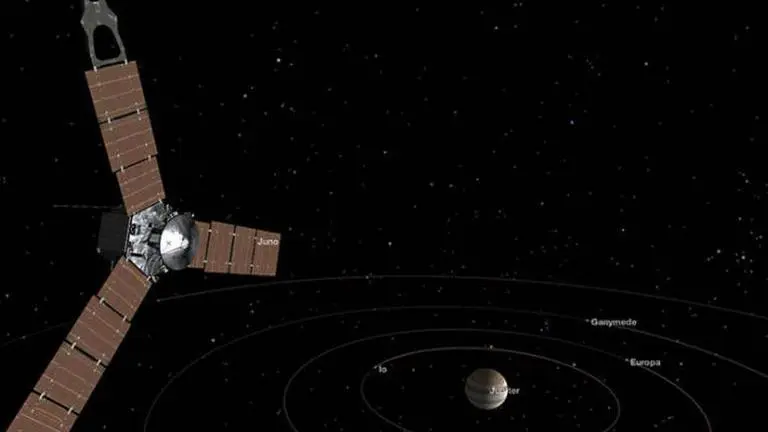Updated 11 October 2020 at 17:20 IST
NASA recreates iconic time lapse footage of Juno spacecraft 'flying' over Jupiter
NASA reconstructed iconic flyover using approximately 2,703 still frames in a 125-fold time-lapse in which Juno spacecraft came within 2,100 miles to Jupiter.
- Entertainment News
- 2 min read

On October 10, NASA shared footage that compiled the images from its Juno mission in which the spacecraft performed its 27th close flyby of Jupiter on June 2. Taking to its official Twitter handle, NASA asked the space buffs to check out what it might have looked like to “fly” over Jupiter. “During the spacecraft's closest approach on June 2, 2020, it came within ~2,100 miles (~3,400 kilometers) of the gas giant’s cloud tops,” NASA said.
NASA reconstructed the iconic flyover using approximately 2,703 still frames in a 125-fold time-lapse. In the footage, the Juno spacecraft came within approximately 2,100 miles (3,400 kilometers) to Jupiter’s cloud tops, as it accelerated to near the giant planet at about 130,000 mph (209,000 kilometers per hour). The video was compiled by citizen scientist Kevin M. Gill, NASA informed in the release, adding, that the scientist compiled almost 41 JunoCam still images and then digitally projected onto a sphere. “The original JunoCam images were taken on June 2, 2020, between 2:47 a.m. PDT (5:47 a.m. EDT) and 4:25 a.m. PDT (7:25 a.m. EDT),” NASA said in the release.
This video uses images from @NASA’s #JunoMission to recreate what it might have looked like to “fly” over Jupiter. During the spacecraft's closest approach on June 2, 2020, it came within ~2,100 miles (~3,400 kilometers) of the gas giant’s cloud tops.😍 https://t.co/YQsd0uqBt8 pic.twitter.com/MOEsxpeqQA
— NASA JPL (@NASAJPL) October 9, 2020
=Fabulously-Good Work!=
— ken collins (@kpcSci) October 10, 2020
You get a sense of "depth" because of the nonlinear-perspective shifts between 'frames'.
Fabulous, Fabulous, Fabulous!
k. p. collins
Wowww... Wowww... 😍🛰At that point, Jupiter’s powerful gravity accelerated the spacecraft to tremendous speed – about 130,000 mph (209,000 kilometers per hour) relative to the planet... It seems that there is still a lot of time, how for a mission to cross those clouds.
— 🛰️Makino🛰️ (@Makino_Voyager) October 10, 2020
Mind blowing. This was SO cool, well done! This would be amazing if it could be converted into a VR Experience!
— Johnathan Milgie (@JMilgie) October 9, 2020
Insane! 😍😍😍
— obi-wan kenobi (@1film_1jour) October 9, 2020
@kevinmgill nice work! 😁
— Marty McGuire (@BackyrdAstroGuy) October 9, 2020
Advertisement
Juno’s gathers info on planet formation
In NASA’s Juno mission the spacecraft rode to the Jupiter with 27th close flybys on June 2, 2020. According to NASA, Juno’s aim was to gather more information about the planet’s formation and evolution using long term technologies installed on the spinning spacecraft that entered the elliptical polar orbit of Jupiter. “Juno would observe Jupiter's gravity and magnetic fields, atmospheric dynamics and composition, and evolution,” astronomers said in a press release. The mission was launched in August 5, 2011, and will end July 2021. “An additional 41 months in orbit around Jupiter and will enable Juno to achieve its primary science objectives,” NASA said.
Advertisement
(Image Credit: NASA)
Published By : Zaini Majeed
Published On: 11 October 2020 at 17:20 IST
